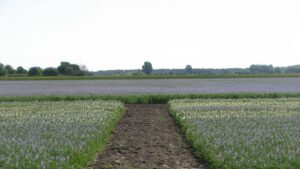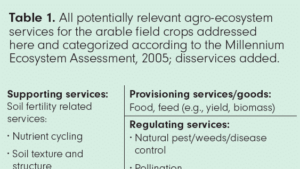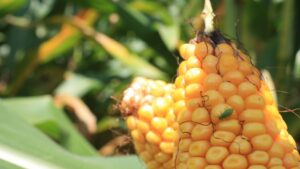The naturalisation of the alien Diabrotica virgifera virgifera LeConte.
The crop that covers the largest area in Austria is maize. It has the highest productivity growth and is grown on about 23 per cent of fields, which is about 308,000 ha. However, the production area is decreasing due to the beetle western corn rootworm (WCR) with its scientific name Diabrotica virgifera virgifera LeConte. This insect has become economically the most significant pest in some parts of Austria.
In 2002, 10 years after its first appearance in Europe in Belgrade, WCR crossed the eastern border into Austria. The beetle was first found along the Hungarian and Slovakian border in Burgenland and Lower Austria. In 2003 it had reached Styria, by 2007 it was discovered in Upper Austria and then a year later in Carinthia. In 2013 the first individuals were found in Salzburg and Tyrol. Maize is mainly grown in the provinces Styria, Upper Austria and Lower Austria but it is also grown in Burgenland and Carinthia.
Because of its close association with maize (Zea mays L.) as a larval and adult host, WCR predominantly inhabits regions where maize is planted consecutively in large monocultures.
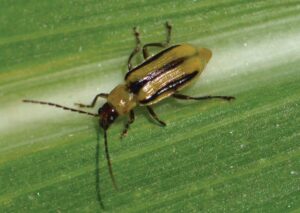
In some regions, chiefly in Styria, maize is the main source of income for farmers, along with Styrian pumpkins grown for making pumpkin seed oil (Cucurbita pepo var. styriaca). As Styria has the most favourable conditions for growing maize compared to the other province in Austria, it is economically possible for farmers to produce maize full- time on the minimal amount of arable land.
Most businesses in this region are involved in small-scale agriculture and 64 per cent of the farms are very small, measuring just 10 ha or less. Thirty-five per cent of the Styrian famers have 67 to 100 per cent maize in their crop rotation, often alternating with the Styrian pumpkin. These small farms and maize monocultures make it easy for WCR to colonize and hard to carry out crop rotation.
In the other provinces, WCR has also become naturalised but so far, due to the economic background, it has been possible to combat the pest with crop control.
During the time when WCR was a quarantined pest (2003-2013), pest control was still required by law and everyone in the EU was confident of its extermination. There was no need for restructuring. There were special quarantine measures in infested zones that banned the movement of contaminated soil and fresh maize plants and forced crop rotation. By committing to these control measures, we should have theoretically eradicated the pest. Therefore crop rotation was enforced by law as early as 2004 in all Austrian provinces. According to this law, maize must be planted at least three times in four years on the same field, except for seed propagation. It was clear from the outset that simply complying with this law wouldn´t be sufficient in combating the pest. Chemical solutions were particularly favoured in respect to seed treatments containing neonicotinoids. However, the WCR population spread throughout Austria. The first damage was observed in Burgenland in 2007 and in Styria in 2011, where the damage is steadily getting worse.
After the temporary restriction in Austria in 2013 (until 2016) of seed treatments containing neonicotinoids (imidacloprid, clothianidin, thiamethoxam) a kind of rethinking began.
Fortunately, in the meantime considerable efforts have been made to continually keep up with developments taking place in science to find sustainable strategies to prevent the pest. Biological products based on nematodes (Heterorhabditis bacteriophora, Heterorhabditis megidis) and entomopathogenic soil fungi were tested. It has been proven that nematodes are highly effective but very expensive and their application is extremely costly. Entomopathogenic soil fungi such as Beauveria bassiana and Metarrhizium anisopliae are cheaper and persistent in the soil but up to now, their efficacy is behind classic insecticides.
The efficacy of both nematodes and soil fungi depends on favourable soil conditions, requiring a certain amount of moisture to keep the biological agents alive. This is rarely the case and the biological agents fail in harming the WCR larvae. Successful research into the formulation of soil fungi will possibly lead to a biological control measure in the future, but currently adequate tools are lacking. One insecticide based on nematodes is authorised in Austria, however no fungal product against the larvae is on the market.
In 2013 and 2014 the WCR population nearly doubled as was discovered when monitoring crops in Styria, and as a result approximately 2,000 ha (three per cent of the fields planted with maize) of maize was destroyed and nothing could be harvested. Farmers saw no way out. In the late summer of 2014, beetles migrated into fields where lettuce was growing. Farmers were unable to sell their produce due to countless beetles crawling on the lettuce leaves.
This means WCR is no longer just a problem for maize producers but is now a threat to the entire agriculture [industry] in Styria. Politicians have taken particular notice of this problem and know that a solution has to be found. In 2014, the situation forced them to approve a stricter provision on crop rotation (two times maize in three years).
Consequently, the small traditional farms, which should have been protected, are jeopardised. Small farms will face economic problems over the coming years as a result of lower incomes. Sowing alternative crops such as wheat (Triticum aestivum) and particularly sorghum (Sorghum spp.) is promoted. Sorghum is best able to utilize manure. This is an important feature for livestock farmers, who are the majority in areas of Styria where WCR populations are largest.
Farmers are cooperating. They realize that changing crop rotation is the only solution. In 2015 17 per cent less maize was sown than the previous year. However, WCR populations continue to increase and at the moment they are so large that crop rotation is no longer effective.
WCR is also being controlled with a seed granular (active agent: cypermethin) and one out of two authorised commercial insecticides (active agent: thiacloprid, acetamiprid).
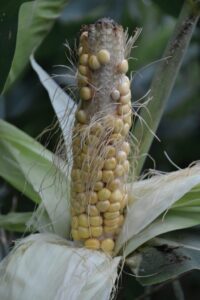
In addition, a new insecticide has been temporarily authorised. It controls populations by disrupting mating. This new biotechnical insecticide is based on powdered zeolite (volcanic rock) blended with the sex pheromone (8-methyl-2-decyl propanoate) of the western corn rootworm. Mixed with water it is spread with commercial plant sprayers, which is enormously advantageous for the user. It is the first time that a biotechnical insecticide has been used on arable land, therefore there is little experience with the product.
Due to its eco-friendliness and species-specific impact, it has all the properties a modern insecticide requires. However, essential issues remain unclear and have to be researched. There is no reliable evidence for duration of effectiveness, waterproofness and impacts on beetles. Clarification is currently being worked on.
The smartness of this product led regional politicians to propagate this insecticide through sponsorship. In Styria about 5,000 ha (10 per cent of the entire maize production area) of arable land planted with maize has been sprayed, whereas in Upper Austria the insecticide has been employed only in seed propagation areas of about 850 ha. Unfortunately, its effectiveness can only be evaluated in the following year when fewer beetles are swarming.
To maintain maize production in Styria and to keep the rate of maize in crop rotation as high as possible, the following strategy is propagated in addition to the use of the biotechnical pesticide.
By sowing late ripening varieties of maize on 25 per cent of the fields, WCR should be gathered to be combated by crop rotation in the following year. Avoiding volunteer grain, weeds of the genus Setaria and flowering catch crops in the surrounding areas should guarantee that all individuals stay in maize and oviposit there. The following year a different crop has to be planted to make sure that no eggs survive.
Fields where maize is rotated with maize should be kept free from WCR. To ensure this, early ripening varieties should be grown so that fertilisation has finished before the majority of WCR swarm. As a result damage can be avoided.
Different crops, rather than maize, should be planted the third rotation year in order to clean up infested fields. This strategy is just a theory. There is currently no empirical evidence of its effectiveness.
Many strategies have been tried and tested to get rid of the pest, notably seed granular with different active agents, insecticides and genetically modified plants, which is banned in Austria. However, ultimately we have to accept that the initial idea of crop rotation is the cheapest and only way to live in harmony with the small swift beetle.
Editor’s Note: Dr. Marion Seiter is Crop Consultant with the Division of Plant Production of the Chamber of Upper Austria



